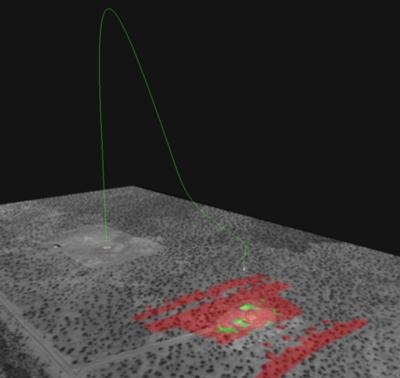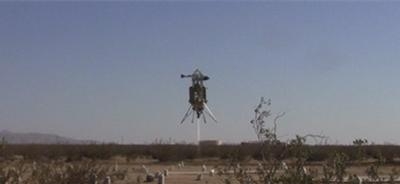Astrobotic Technology And Masten Space Systems Integrate Platforms To Validate Autonomous Capability
In a test conducted June 20 in Mojave, CA, the Astrobotic Autolanding System (AAS) successfully directed the Xombie vertical-takeoff vertical-landing suborbital rocket in a closed-loop test. In this technology demonstration, a computer vision system scanned the landscape, selected a landing spot, and directed a rocket-powered lander to a safe touchdown point, all without a human operator. The flight test was funded by the Flight Opportunities Program of NASA’s Space Technology Mission Directorate and conducted at the Mojave Air and Space Port in Mojave, CA.

Future NASA and commercial missions will likely target destinations with challenging topography and limited communication, such as unmapped asteroids, surface rendezvous sites for sample return, and terrain features like polar peaks, crater rims, and skylights on Mars and the Moon. The Astrobotic Autolanding System (AAS) autonomously selects a landing location for a robotic spacecraft to safely land at a precise location, a capability that is critical for landing in such hazardous terrain.
Unlike typical drone landings, which rely on GPS, the AAS uses a technique called Terrain Relative Navigation to precisely track the spacecraft’s location and attitude using only cameras and an inertial measurement unit (IMU). This is necessary in environments where GPS is not available, like the Moon. The AAS then uses LIDAR to detect hazards and select a landing point. “Conceptually, this is like the Apollo missions where the astronauts navigated to a safe landing by looking out the window of the LEM,” Kevin Peterson, Astrobotic’s CTO, said in a news release. “In this case, we have an onboard computer instead of an astronaut, and the cameras, IMU (Inertial Measurement Unit), and software are so precise that they can track the craft’s location to within a few meters.”
Developing navigation and hazard avoidance for a self-landing, rocket-powered spacecraft on Earth is challenging, due to the need to test in the same operating conditions that the system would encounter in a planetary landing. Astrobotic and Masten collaborated on a framework that enabled the test flight without prior knowledge of exactly where the rocket would choose to land. Astrobotic’s AAS scanned the landscape and selected a safe landing point. Masten’s onboard flight system received input from the Astrobotic vision and navigation system, validated the input, and accepted the selection of a path to the touchdown point. The flexible architecture enables flight testing while simultaneously limiting risk to vehicle, payload, and people. The successful flight was the capstone of only a few months of work together.

“Today was a great demonstration of how a rocket powered lander can select a safe landing site without human intervention," said Masten CEO Sean Mahoney. "There are so many innovations on display in this flight campaign from both teams that it really drives home the reality that barriers to space access are falling.”
This successful closed-loop flight was an end-to-end validation of the Astrobotic Autolanding System’s precision landing capability in a relevant flight environment. The development focus will now shift to implementing the AAS with space-rated sensors and avionics in order to land Astrobotic’s Griffin lander safely on the Moon.
Masten’s terrestrial rocket testbed next takes to flight later this year in support of future rocket landing technologies, while the company continues to build the next generation of vertical take off/vertical landing vehicles.
(Images provided by Masten Space Systems)
 Airbus Racer Helicopter Demonstrator First Flight Part of Clean Sky 2 Initiative
Airbus Racer Helicopter Demonstrator First Flight Part of Clean Sky 2 Initiative Diamond's Electric DA40 Finds Fans at Dübendorf
Diamond's Electric DA40 Finds Fans at Dübendorf ANN's Daily Aero-Term (04.23.24): Line Up And Wait (LUAW)
ANN's Daily Aero-Term (04.23.24): Line Up And Wait (LUAW) NTSB Final Report: Extra Flugzeugbau GMBH EA300/L
NTSB Final Report: Extra Flugzeugbau GMBH EA300/L Classic Aero-TV: 'Never Give Up' - Advice From Two of FedEx's Female Captains
Classic Aero-TV: 'Never Give Up' - Advice From Two of FedEx's Female Captains




